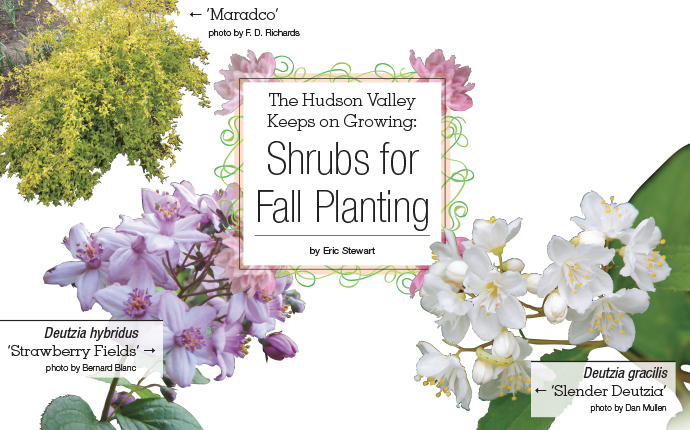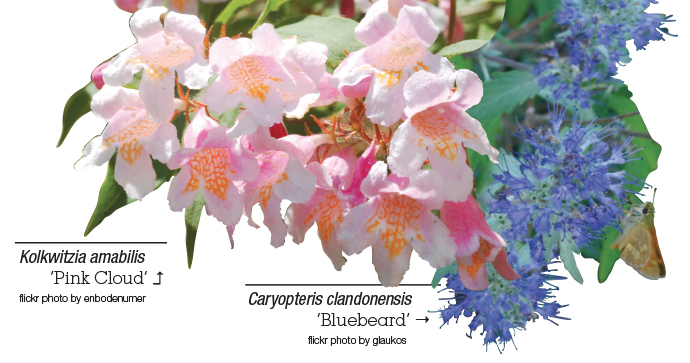
Now that the bugs, heat, and humidity of summer have past, why not spend a few hours in the crisp autumn air preparing for an even more beautiful garden next season by planting a few shrubs? Shrubs create the foundation, or ‘bones,’ of the garden, forming the structure upon which plantings of perennials and annuals are built. They add privacy and beauty to the yard, screen unwanted views, and provide food and shelter for wildlife. In addition, planting a shrub or two can also be a great family project—a way to get kids outdoors and focused on something other than a glowing screen.
Now the question arises:What do I plant?
The following are a few suggestions based upon years of experience both in my own garden and those of my clients. Better yet, they are all easy to maintain, deer-resistant, and lovely.
Deutzia
These are a group of old-fashioned flowering shrubs that your grandmother or great grandmother might well have grown. Named for an 18th-century amateur Dutch botanist and plant enthusiast, Johann van der Deutz, these showy shrubs of East Asian origin are great when used in a sunny mixed border or foundation planting. The larger varieties make a wonderful informal hedge or screen. Why they are not more commonly planted is simply beyond me. In my garden, Deutzias are reliably deer-resistant and flower profusely in late spring. They also seem to thrive on neglect. Sometimes called ‘Slender Deutzia,’ Deutzia gracilis is a medium-sized shrub that grows 2-4' tall and wide. ‘Nikko’ is a dwarf variety that only grows perhaps to 2' tall and features white flowers.
‘Chardonnay Pearls’ is another white-flowering dwarf variety, but one that is a true standout in the garden, boasting glowing golden-green foliage. My favorite Deutzia, however, is a larger pink-flowering variety, Deutzia hybridus ‘Strawberry Fields.’ In late May or early June, it covers itself with bright pink blooms tinged with deeper crimson. The more sun it gets, the better the floral display. These carefree shrubs usually grow 5-6' tall and wide. However, the ones in my yard with a southwestern exposure top out at about 7-8' tall. When not blooming, they are stately vase-shaped shrubs with pleasant apple-green foliage. Better still, deer have never touched those that grow in various locations throughout my unfenced garden. Deutzias are adaptable to most soil conditions and deserve a spot in most any garden in full to mostly sunny spots.

Pink Cloud Beauty Bush
(Kolkwitzia amabilis ‘Pink Cloud’)
This is another old-fashioned shrub that is very similar in appearance to Deutzia ‘Strawberry Fields,’ but this beauty grows even larger. I have seen some older specimens reach 10-14' tall and 8-12' wide. The flowers of Beauty Bush are similar in profusion to those of Deutzia ‘Strawberry Fields,’ but they are a paler shade of soft pink or pale mauve. The individual flowers themselves resemble small snapdragons or orchids and appear in great clusters all along the ends of arching branches. In my Zone 5 garden, Beauty Bush blooms a week or two prior to Deutzia. Please note that Kolkwitzia will not bloom if it is constantly being cut back to maintain a smaller stature than nature intends, so be sure to give it plenty of room in a location that gets full sun. Due to its size and the profusion of flowers when in bloom, these large shrubs are easily mistaken at first glance for a shrubby-looking flowering crab apple. That’s how much impact they bring to a landscape. When not in bloom, they are simply a large, grayish-green and a presence that creates a great visual anchor or backdrop for a mixed border, screen, or hedge.
For partially shaded areas, consider planting Kolkwitzia amabilis ‘Maradco,’ which is usually seen under the trademarked name “Dream Catcher.” This is a Beauty Bush that flourishes in shady areas protected from intense afternoon sun. Its gracefully arching stems reach up to 6-8' in height and feature the same lovely pink spring flowers of its cousin, ‘Pink Cloud.’ However, “Dream Catcher” boasts lovely golden-green foliage with pink-tinged new growth. It really brightens a partially shaded garden and forms a wonderful backdrop for shade-loving perennials. In the fall, its foliage turns a stunning golden orange. This is a really great shrub. Plant one or two of either of these varieties of Beauty Bush, and you will be amply rewarded with low-maintenance beauty for many years.
The earlier in autumn you plant, the better!
Blue-Mist Shrub (Caryopteris clandonensis)
a.k.a. Bluebeard or Blue Mist Spirea
This is another of my favorite deer-resistant shrubs that is ideally suited for sunny, dry, well-drained locations. It features fragrant blue-gray foliage and lovely bluish-purple flowers that appear in late summer and early fall. Given lots of sun and average to dry soil, this is another shrub that seems to flourish with a minimum of care. Growing to 2-3' tall and wide, Caryopteris makes an ideal companion for lavender and other herbs that thrive in a Mediterranean-like environment. Unlike lavender, however, which I treat in most locations as an annual, Caryopteris is reliably hardy in Zone 5 gardens, though they do tend to be somewhat short-lived—especially after a winter as severe as our last. This shrub may also require cutting back in early spring to remove branches damaged by winter snow, as well as to encourage new growth and prevent a leggy appearance. ‘Longwood Blue’ is my favorite cultivar, and its late-season blue flowers are a magnet for pollinating insects this time of year. If you fancy the same blue flowers paired with bright yellow foliage, try the cultivars ‘Worcester Gold’ or the closely related shrub, Caryopteris lisaura ‘Hint of Gold.’ The golden-green leaves of the latter are larger and more robust in appearance; however, both are striking, low-care plants and make a dramatic focal point or accent in a sunny garden or border. Finally, since these lovely shrubs are probably blooming as this article appears, finding them should be easy this time of year.
Lastly, a few words of warning regarding fall planting:
Plan to finish installing additions to your garden by the end of October or early November depending upon weather conditions. Shrubs ideally need a minimum of four to six weeks to acclimate to their new homes prior to the ground freezing (which usually happens here in mid to late December). With spring-flowering bulbs, you have a little more time to play with. I have been out planting daffodils when the first snowflakes begin to fall, but with shrubs, the earlier in autumn the better.
Now go out and plant something!

Eric Stewart is a garden designer, writer, and artist who lives in Accord. He may be reached at Greenman Garden Design; greenmangarden.com; 845-687-0407; or via email at elsgreenman@aol.com. Aside from planting and designing gardens, he has also recently completed his first novel.

